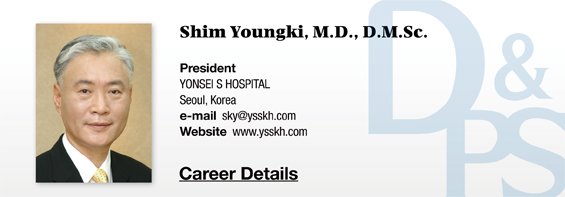“Medical director Shim Youngki of Yonsei S Hospital is the first plastic surgeon who performed the European method of varicose vein therapy in Korea. Since opening the hospital specializing in varicose veins in 1995, he has developed an optimal treatment method for Asians and applied it to clinical practice so far. In this series, Dr. Shim will introduce different therapies of venous diseases, ranging from getting rid of unsighty veins or spider veins to laser therapy, based on his ample clinical experiences. We hope this series would be much appreciated by those who are interested in venous disease treatments.”
Varicose veins is a venous disease with a very long history. It is known to be first described by Hippocrates and surgically treated by Galenos around the second century B.C. The term ’varicose’ means tortuous and saccular expansion in Latin.
Varicose veins can be divided into primary and secondary, depending on the pathogenesis. Most cases are primary and the obstruction to blood flow by deep vein thrombosis is the less common secondary cause. According to reports, about 2-3% of the American population and 1-2% of the population worldwide are affected by varicose veins.
[Advertisement] MAGNUM(Q-switched Nd:YAG Laser) – Manufacturer: (www.i-dana.com)]
As the most cases do not manifest symptoms and progressing slowly, varicose veins was considered a spontaneous phenomenon in the past. People even thought of it as a symbol of power or hard work because they believed that it arose from overexertion. Since it was not particularly painful, people did not bother with or even feel the need for treatment.
With recent improvement in living conditions, about 10-30% of patients with varicose veins visit hospitals complaining of pain and discomfort. The statistics may vary, but according to my clinical experience, more than 70% of the patients want aesthetic improvement.

Again, varicose veins is an asymptomatic, slowly progressing condition that even doctors had thought it was not worth treating, if not accompanied by a complication. They never recognized it as a chronic disease that may lead to various complications and side effects. The fundamental pathophysiology of varicose veins is venous valve dysfunction. The reflux caused by valve dysfunction creates venous hypertension beneath the valve, resulting in the development of varicose veins. The venous pressure is now delivered to the distal superficial veins, increasing the permeability of the capillaries, followed by interstitial edema and RBC red blood cell extravasation. As a result, the skin develops eczema, dermatitis and even leg ulcer in chronic, severe cases. Superficial thrombophlebitis can be the main complication of varicose veins. Therefore, normalization of blood flow, as well as aesthetic improvement, should be the therapeutic object of the treatment.
Varicose veins was defined by Arnoldi (1957) as veins that have become enlarged and tortuous, regardless of their size and shape. Dodd and Cockett (1956) defined it as saccular, venous, tortuous expansion caused by continuous elevation of venous pressure from the presence of valve dysfunction. Here, the presence of valve dysfunction is the most important criterion for the definition of varicose vein.
-To be continued-
▶ Next Artlcle : #1-2. Definition of Varicose Veins





















